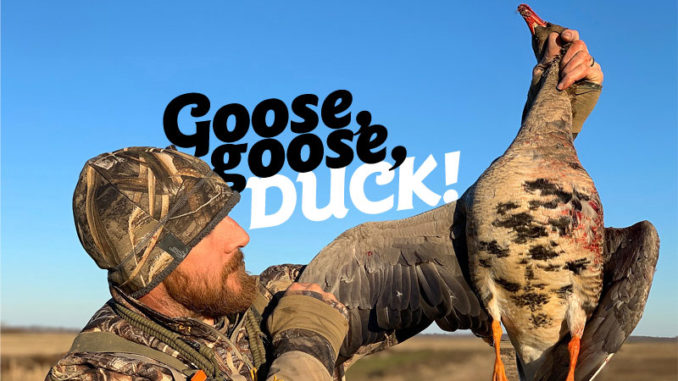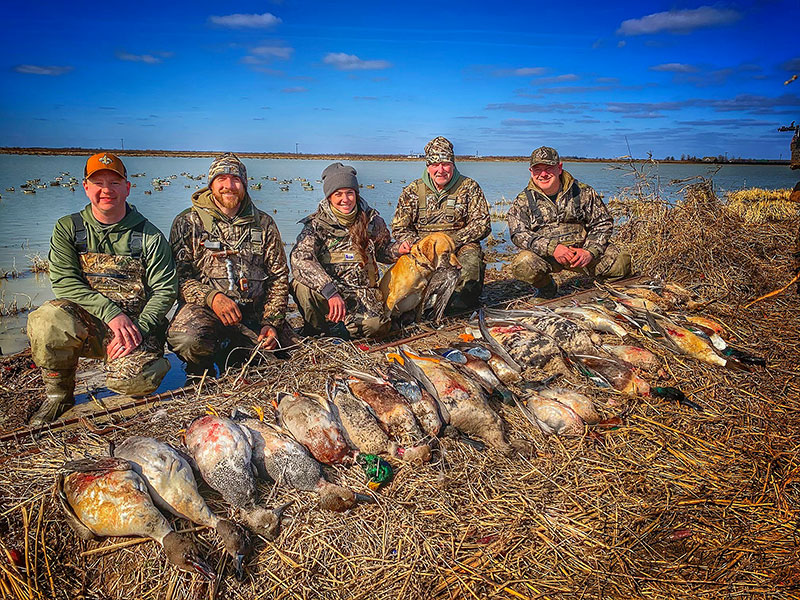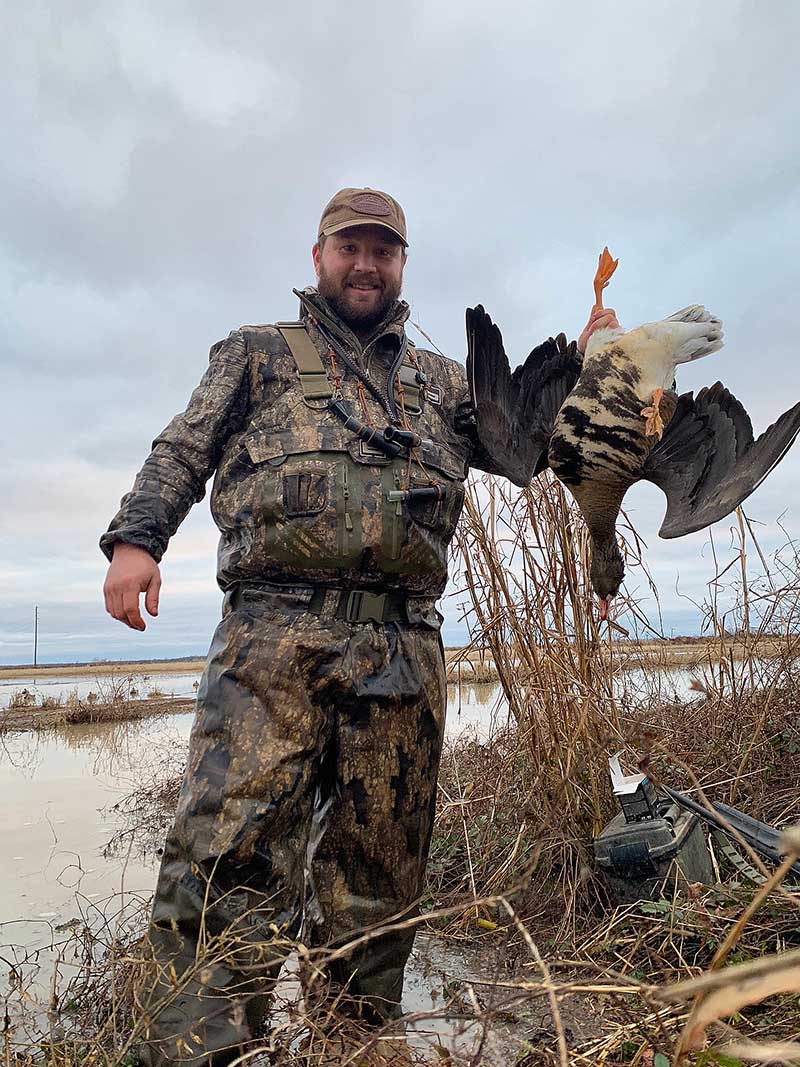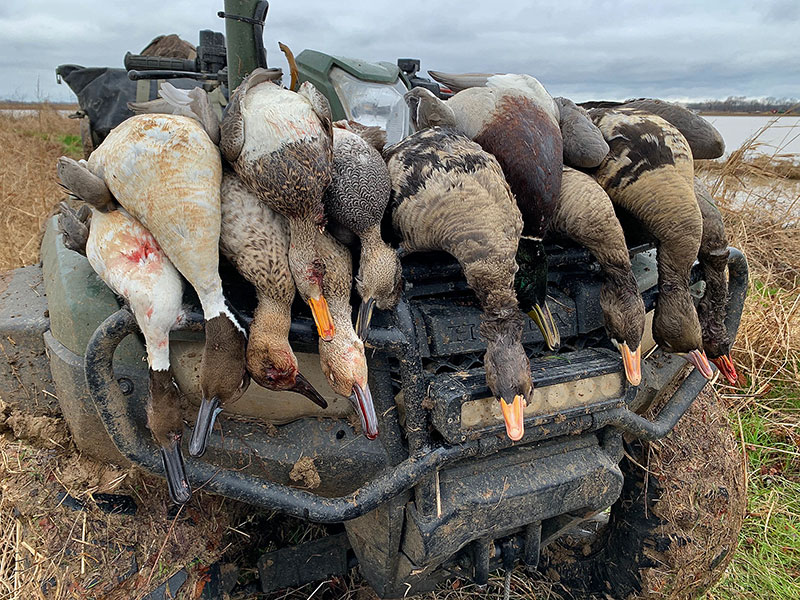
Take advantage of those times when Louisiana’s goose seasons match up with duck season. The big birds can provide some great action and even save some mediocre duck trips.
Sure, duck hunting is fantastic, but while the number of ducks may vary, there’s been a more-consistent game in town the past few years.
Large numbers of geese are almost always in the harvested agriculture fields of northeast Louisiana. Early goose season dates give hunters great opportunities for these early arrivals. And all-season long, geese can fill in, providing action for waterfowlers no matter where they hunt.
The change also means that geese don’t always get second billing. Sometimes, they are the headliners. An increased daily bag limit of three per hunter for whitefronted geese, aka specklebellies, moves them up even higher on hunter’s radar.
“I think that forever, it has been a matter of people going duck hunting, and if some specks show up, that’s just a bonus,” said guide Maddie Wiggins of Monroe. “But now that duck hunting is getting harder and the numbers of birds isn’t always what we hope for, specks are getting a lot more attention.”
Wiggins, a partner in the Mallard Crossing Guide Service, hunts ducks and geese across northeast Louisiana. Another expert, Cole Barthel of Rayville, co-host of Simmons’ Sporting Goods’ All Things Hunting TV show on the Sportsman Channel, has the same opinion.

“I’ll be honest; I’m a duck man at heart, and I’m deer hunting a lot during the early goose season, but man, I’ve got lots of friends who go goose hunting every day,” Barthel said. “We certainly spend more time on specks now than we used to. It’s a lot of fun, and when the specks are right, it’s just as exciting as duck hunting. During the regular season, there are a lot of days when geese make the duck hunting worth it.
“A lot of times, specks will work just like ducks. That’s one thing that makes them exciting. They will actually work and come over you. Snow geese and blues are like wood ducks. They know where they are going, and there’s nothing you can do to change their mind. But specks are fun, and they are also some fine eating, right up there with teal and mallards.”
Wiggins Always has a plan
“If you ask 10 different guys what’s most important for killing geese, you may get 10 different opinions,” Wiggins said. “We have found that it is important to go find the geese the afternoon before you are going hunting. It is our experience that when the specks leave at dark to go roost, the next day, they will typically end up going to the last place where they left off the next morning. It’s important when you go in there that you don’t spook them. We will wait ’till they leave, then go put out our blinds and brush them.”
Wiggins has gone more to hunting out of layout blinds because he can move with the ducks. He recommends brushing the blind on the levee where you are going to hunt with materials from that field. Sometimes, brush and stubble from fields don’t all look the same, and based on how long they have been harvested, they can even be different colors.
“Specks may be slower, but they are so much smarter than people give them credit for,” Wiggins said. “They pick up on everything, and if you mess up, they’ll let you know with a little high pitch murmur that means, ‘I see you down there. Better luck next time,’ and they are gone.”
He also brushes his layout blind in the field, because if you do it at camp and bring it with you, if there is a frost on the levee and field, and your blind doesn’t have frost on it, it sticks out like a sore thumb. By the same token, he always puts his decoys out as late as possibly the morning of the hunt.

“If your decoys sit out there in a frost and get a gleam on them, the geese are going to flare,” he says. “You want to keep it real. And real geese don’t gleam.
“We are fortunate to have some great duck holes, and we are always after ducks during the season,” he said. “But we never go to the field without our goose calls and decoys. Some days when hunting for geese is good, that’s all we focus on. I find more and more people who we take hunting would just as soon limit out on three big specks as they would on six little ducks.”
Wiggins also uses another little trick to keep the geese from spying him before it’s too late. He will often set up the spread, then set up the layout blinds to the side where the geese won’t be flying straight into the hunters.
“We kind of try and set up where they aren’t coming right down the pike looking at us,” he said. “For instance, if we set up the spread to try and drag them in from the north or south, we’ll try to position ourselves a little to the east or west.
Wiggins hunts regular pit blinds when they are working and said there are several brands of great layout blinds for an alternative. He is left-handed and has always shot a Benelli shotgun because, at one time, they were the only major gunmaker that made an automatic shotgun for lefties. His favorite is a Benelli Super Black Eagle. He shoots Winchester DryLok Super Steel High Velocity Waterfowl No. 2 shells for geese.

Barthel’s best tips
According to Barthel, the main things with goose hunting are the same things that matter most with ducks.
“You’ve got to find a place where they want to be,” he said. “We call it ‘Being on the X.’ In other words, this is the spot they want to come to, whether it is for food or where they fly just out of instinct. Most of the time, they will respond to decoy spreads, and we always have out a few goose decoys — you need to do that. But if they aren’t coming to the spread, you need to do a little scouting and go to where they want to be. That can be another blind or just hidden in some natural cover along the edge of a field.”
Barthel said many times geese will respond to a call better than to decoys. If they are flying nearby and you call correctly, you can get them overhead. The key is to pay close attention to what they want and make sure you don’t overcall. He uses Singleton Game Calls for geese.
Barthel said his experience has taught him that if geese are approaching the spread, you need to shut down the spinning-wing decoys. Geese don’t seem to like the spinning wings the way ducks do.
Since he’s hunting ducks and geese at the same time, he likes to shoot No. 2 Browning shells in his 31/2-inch Browning Maxus II shotgun. They are good for ducks and can reach out and get geese, too. If he’s just goose hunting, he goes to a slightly larger shot, Double BB. It’s a dependable gear combo for him and rugged enough to handle a long season.
It isn’t uncommon to see literally thousands of geese in the waterfowl areas of the state, especially in large agricultural areas. Barthel said if you pay attention, though, the snow geese and the specks don’t hang out a lot together. Snows will usually bunch up, and specks will be on the outside perimeter unless a huge field of geese get stirred up. When that happens, the sky can literally be covered in geese, and it can almost sound like a jet airplane taking off.
Barthel mentioned that specks are great-tasting dinner fare. Many times after a successful hunt, they’ll come in to camp, breast out the geese, butterfly them and just cook them in a hot skillet in butter with salt and pepper. They also like to marinate them when they have time and put them on a grill. Unlike ducks, they don’t wrap them in bacon or stuff them. They just eat them plain.

Goose by the book
Louisiana’s 2021- 2022 goose season opens Nov. 6 and runs through Dec. 5 in both the East and West zones.
A second split in the East Zone runs Dec. 18 through Jan. 30, 2022. Two secondary splits are open in the West Zone: Dec. 18-Jan. 2, 2022 and Jan. 10-Feb. 6, 2022.
The daily bag limit is three white-fronted (specklebelly) geese, one Canada goose or 20 light geese (snow, blue or Ross).
“Conservation Order” hunts for light geese open later in the year, with no limits, legal use of electronic calls and unplugged shotguns. Check your regulations book for more details. Migratory game bird schedules and regulations can be found on pages 29-32 in the Louisiana 2021-2022 Hunting and WMA Regulations pamphlet.
These conservation seasons are allowed to try and control overpopulation of these geese.


